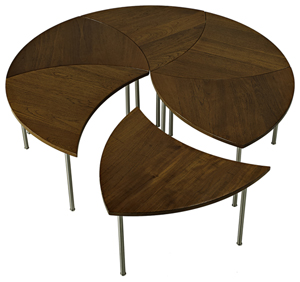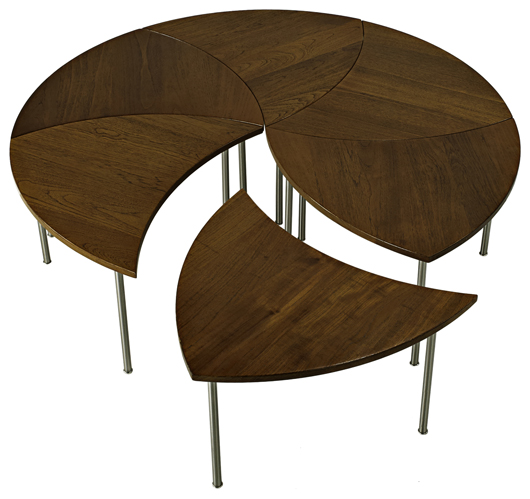
Small rooms need small furniture, but large families need large tables. This problem has been solved in a variety of ways since the 17th century. Homes with long center halls, which were needed to keep the house cool filled the space with several tables that could fit together to form one large table.
A favorite style was a four-legged center table and two end tables with curved leaves that could be raised to be level with the center table or dropped to hang at the side. By Victorian times, the table could be on a center pedestal with sides that pulled out so leaves could be added. By the late 1890s, patented slides and hardware made it possible to pull both ends of a table out, then to fill the vacant space with leaves that matched the tabletop. And by the 1900s, some tables had self-storing leaves that popped into place from under the tabletop when the top was turned or pulled out. But the most interesting and rarest are round tables made larger by the addition of wedge-shaped pieces, or a group of tables that could be made into one round table.
Peter Hvidt (1916-1986) was an architect and furniture designer in Copenhagen, Denmark. He made furniture, usually of teak and steel, in the 1960s. Pieces were very streamlined in the prevailing Danish style – thin legs and arms, no fancy trim, very little upholstery. The unique table was made of three curved shapes that could be put together in different ways. There could be one large, round table, a middle-size table or a small table for one. Rago Arts and Auction Center in New Jersey sold one recently for $3,750.
Q: I have some plates marked “Edelstein, Bavaria, Maria Theresia.” There’s also a number I can’t read on the bottom. The plates have a plain center and a slightly scalloped edge trimmed in gold, gold leaves and gold flowers. Can you tell me who made them?
A: The Edelstein Porcelain Factory was located in Kups, Bavaria, Germany, from about 1934 until a few years ago. Dishes marked “Maria Theresia” can be found with several different decorations, so it may be the shape’s name. The number is a pattern number. Maria Theresia dishes are part of an inexpensive line. A plate is worth less than $10.
Q: I recently acquired a Mobo pressed-metal child’s riding horse. The label on the front reads “It steers!” and “Sebel Products Ltd., New York.” It’s in good condition, with little paint loss. Can you tell me when it was made and its approximate value?
A: D. Sebel & Co. was founded in East London in 1921 and made various metal products. It made metal furniture and toys beginning in the 1940s. The Mobo Bronco riding toy, the company’s best-known toy, was made from 1947 to 1972. When the rider pushed on the stirrups, the horse moved forward. The mechanism was patented in 1942, but production didn’t begin until 1947. Several different models of the horse were made. “Magic Steering” was added in 1950. The horse could be made to turn by pushing on one stirrup. The company opened a factory in Erith, Kent, England, in 1947 and a subsidiary in New York City in 1948. A Mobo horse probably would sell at auction for $100 to $325. The better the condition, the higher the price.
Q: Does old sheet music have any value? We have some that was published between 1880 and the 1940s. We’re trying to raise money for a local charity, and thought we could frame some of the more colorful ones and see if they would sell. We don’t know what to charge for them. Can you tell us?
A: A piece of sheet music published in the 20th century usually sells for about $5. Earlier sheet music may sell for more, especially if the cover is interesting, colorful or appeals to collectors. Most collectors want sheet music that’s complete, untrimmed, unframed and in good condition. Start at $5 to $30 for unframed examples. Ask more if they’re very unusual.
Q: I have a John F. Kennedy “friendship spoon.” One side of the handle is marked with the year “1961.” The other side just has the number “19,” because the last two numbers of the year are missing. I saw one online that had all four numbers on each side. Why would two numbers be missing? What is the value of this spoon?
A: Wm. Rogers Manufacturing Co. made souvenir spoons honoring the 1962 flight of Friendship 7 in both silver plate and gold plate. Piloted by astronaut John Glenn, it was the first manned orbital flight launched by the United States. In 1961, President Kennedy announced the goal of landing a man on the moon by the end of the decade. Seven astronauts were chosen, and a tradition of letting the astronauts choose the name of their space capsules began with the first flight. John Glenn’s children chose the name “Friendship,” and the number “7” was added in honor of the original group of astronauts. Most of the Rogers spoons found online have “1961” and “1963” underneath a bust of President Kennedy, and obviously were made after he was assassinated in 1963, but we found one pictured that had only the number “19” on the right side of his bust. It was listed as being made in 1962. Value: about $10.
Tip: Decorated glasses given as promotions at fast-food restaurants often fade in sunlight.
Terry Kovel answers as many questions as possible through the column. By sending a letter with a question, you give full permission for use in the column or any other Kovel forum. Names, addresses or email addresses will not be published. We cannot guarantee the return of any photograph, but if a stamped envelope is included, we will try. The volume of mail makes personal answers or appraisals impossible. Write to Kovels, Auction Central News, King Features Syndicate, 300 W. 57th St., New York, NY 10019.
CURRENT PRICES
Current prices are recorded from antiques shows, flea markets, sales and auctions throughout the United States. Prices vary in different locations because of local economic conditions.
- Camark vase, light overflow, gray, black, paper label, 5 inches, $17.
- Paperweight, Sheffield Milk, dairy cows, trees, glass, round, 1 3/8 x 3 inches, $145.
- Jigsaw puzzle, Yellow Kid, box, 1890s, 13 3/4 x 14 inches, $150.
- Sugar basket, silver plate, oval, upswept ends, gadrooned, flower band, beaded swing handle, c. 1885, 4 1/4 inches, $155.
- Shaving mug, occupational, blacksmith, working on metal, Xirola Roselli, 1913, 3 3/4 inches, $180.
- Sandwich glass curtain tiebacks, opalescent rosette, 1800s, 8 pieces, $235.
- Candle stand, mahogany, round, beaded edge, twist-turned baluster column, turned base, c. 1850, 27 inches, $245.
- Moulton bicycle, folding, front suspension, white, 1960, $375.
- Tole tray, “Le Serment de Horaces” (Oath of the Horatii), Jacques-Louis David, pierced handles, c. 1810, 29 x 22 inches, $1,340.
- Weather vane, rooster, cast sheet iron, Rochester Ironworks, Rochester, N.H., c. 1880, 24 x 23 inches, $2,480.
Available now. The best book to own if you want to buy, sell or collect – and if you order now, you’ll receive a copy with the author’s autograph. The new Kovels’ Antiques & Collectibles Price Guide, 2013, 45th edition, is your most accurate source for current prices. This large-size paperback has more than 2,500 color photographs and 40,000 up-to-date prices for more than 775 categories of antiques and collectibles. You’ll also find hundreds of factory histories and marks, a report on the record prices of the year, plus helpful sidebars and tips about buying, selling, collecting and preserving your treasures. Available online at Kovelsonlinestore.com; by phone at 800-303-1996; at your bookstore or send $27.95 plus $4.95 postage to Price Book, Box 22900, Beachwood, OH 44122.
© 2013 by Cowles Syndicate Inc.

ADDITIONAL IMAGE OF NOTE


